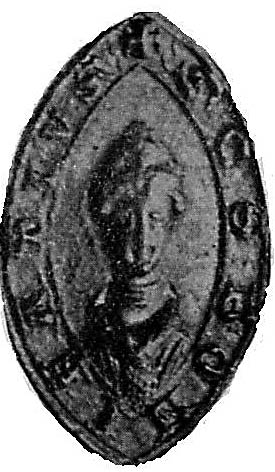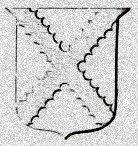Alexander de Kininmund was a 14th-century Scottish churchman. The first mention of Alexander occurs when, as a canon of Dunkeld he is one of three ambassadors sent by King Robert I of Scotland to Avignon in 1320. The purpose of this embassy was to present a letter to Pope John XXII known as the Declaration of Arbroath. As a papal chaplain and lawyer, he was well qualified to argue the Scottish cause, and Barrow makes a strong case that he was, in fact the author of the document.
Elisaeus Adougan was a late 14th century and early 15th century Scottish cleric. His name has been said to have occurred for the first time in a papal letter datable to 25 November 1390, but this letter is simply a repetition of another addressed to him, dated 2 August that year; both letters address him as the rector of the parish church of Kirkmahoe, and authorise him to take up the position of provost of the Collegiate Church of Lincluden providing he resigned Kirkmahoe within a period of two years.

Gilbert was a 13th-century Cistercian monk, abbot and bishop. His first appearance in the sources occurs under the year 1233, for which year the Chronicle of Melrose reported that "Sir Gilbert, the abbot of Glenluce, resigned his office, in the chapter of Melrose; and there he made his profession". It is not clear why Gilbert really did resign the position of Abbot of Glenluce, head of Glenluce Abbey in Galloway, in order to become a mere brother at Melrose Abbey; nor is it clear for how long Gilbert had been abbot, though his latest known predecessor is attested last on 27 May 1222. After going to there, Gilbert became the Master of the Novices at Melrose.
Odo Ydonc was a 13th-century Premonstratensian prelate. The first recorded appearance of Odo was when he witnessed a charter by Donnchadh, Earl of Carrick, on 21 July 1225. In this document he is already Abbot of Dercongal, incidentally the first Abbot of Dercongal to appear on record.
Thomas de Buittle [Butil, Butill, Butyll, Butyl, Bucyl] was a Scottish prelate, clerk and papal auditor active in the late 14th and early 15th centuries. Probably originating in Galloway, Scotland, Thomas took a university career in canon law in England and France, before taking up service at the court of Avignon Pope Benedict XIII. He obtained a number of benefices in the meantime, including the position of Archdeacon of Galloway, and is the earliest known and probably first provost of the collegiate church of Maybole. The height of his career came however when the Pope provided him to the bishopric of Galloway, a position he held from 1415 until his death sometime between 1420 and 1422.

Robert was a 13th-century prelate based in the Kingdom of Scotland. He was successively Archdeacon of Ross and Bishop of Ross; he is the second Robert to have held the bishopric of Ross.
Robert Capellanus, was a chaplain of King William I of Scotland and afterwards, Bishop of Ross (1214–1249).
John Fraser [also, more commonly then, Frisel or Frisell] was a late medieval Scottish prelate. Born about 1429, or 1430 if later tradition can be believed, with strong connections to the burgh of Linlithgow, Fraser held a variety of high-level ecclesiastical positions in Scotland, including being the first Dean of Restalrig collegiate church before becoming Bishop of Ross in 1497, a position he held until his death in 1507.
Thomas Hay was a 15th-century Scottish prelate. A canon of the diocese and cathedral of Aberdeen, on the translation of William Elphinstone from Bishop of Ross to Bishop of Aberdeen, Hay was provided as Elphinstone's successor in Ross, this occurring on 16 May 1483. He was probably the Thomas Hay who held the Aberdeen prebend of Turriff.
Robert de Fyvie [also de Fyvin] was a prelate based in the Kingdom of Scotland in the last quarter of the 13th century. Perhaps coming from Fyvie in Formartine, from a family of Teesdale origin, Robert was Archdeacon of Ross and a student at the University of Bologna by 1269. In 1275, he was not only a graduate but the new Bishop of Ross, a post he held until his death in the first half of the 1290s.
Roger was a churchman based in the 14th century Kingdom of Scotland, and active as Bishop of Ross from 1325 until 1350. Before attaining this position, Roger was a canon of Abernethy; it is possible that Roger was an Augustinian, because it is often thought that Abernethy did not become a collegiate church until some time after 1328, after the marriage of the Abernethy heiress to the Earl of Angus; this however is not certain, as the exact details of Abernethy's transition from being an Céli Dé abbey to an Augustinian priory to a secular college are only vaguely understood.
Alexander de Kylwos – written alternatively as Frylquhous, Kylquos, and a variety of other forms – was a Scottish churchman and prelate active in the second half of the 14th century. He is known to have held senior positions in three bishoprics, and senior offices in two, before being elected and appointed Bishop of Ross in 1371. Though his episcopate is relatively obscure, he seems to have spent almost all of it inside or around his province, was closely associated with William III and Euphemia I, successive rulers of Ross, and was an associate of the famous Alexander Bur, Bishop of Moray, during the latter's struggle with Alexander Stewart, the son of the King later known by the nickname "Wolf of Badenoch".

Albin was a 13th-century prelate of the Kingdom of Scotland. A university graduate, Albin is known for his ecclesiastical career in the diocese of Brechin, centred on Angus in east-central Scotland.
Laurence de Ergadia was a thirteenth-century Scottish bishop. Probably from the MacDougall kindred of Argyll, Laurence had become a Dominican friar and presumably university graduate before being elected Bishop of Argyll, an election which took place sometime between 1262 and 1264. Although the election was quashed by the Pope in 1264, the Pope gave him a fresh provision to the bishopric. Laurence appears intermittently in the records during his three and a half decade episcopate, but his activities in his own diocese are badly recorded. He died as Bishop of Argyll sometime in either 1299 or 1300.
Fionnlagh MacCailein or Finlay Colini was a medieval Scottish bishop. Both his early life and the details of his career as Bishop of Dunblane are not well known, however it is known that he held the latter bishopric between 1403 and his death in 1419. He was part of the circle of Robert Stewart, Duke of Albany, and was one of the many clerics from west and central Gaelic-speaking Scotland who benefited from the latter's patronage. He is said to have authorised the construction of the first bridge over the river Allan at Dunblane.
Simon is the third known 12th century Bishop of Dunblane. Nothing is known of Simon's background as there are numerous Simons in Scotland in this period, both native and foreign. There is a Symon de Liberatione who witnessed a charter of King William the Lion and whom Watt and Murray suggested may have been the later Bishop of Dunblane, while there was in the same decade a local landholder and ecclesiastical patron in the diocese of Dunblane called Simón son of Mac Bethad.

Nicholas de Balmyle, also called Nicholas of St Andrews, was a Scottish administrator and prelate in the late 13th century and early 14th century. A graduate of an unknown university, he served his earliest years as a clergyman at St Andrews, moving on to hold churches in Lothian as well as deputising to two archdeacons of Lothian.
Walter de Coventre was a 14th-century Scottish ecclesiastic. There is no direct evidence of his birthdate, his family, or his family's origin, although he may have come from the region around Abernethy, where a family with the name de Coventre is known to have lived. Walter appeared in the records for the first time in the 1330s, as a student at the University of Paris. From there he went on to the University of Orléans, initially as a student before becoming a lecturer there. He studied the arts, civil law and canon law, and was awarded many university degrees, including two doctorates. His studies were paid for, at least partially, by his benefices in Scotland. Despite holding perhaps more than five benefices at one stage, he did not return to Scotland until the late 1350s.
The Archdeacon of Brechin was the only archdeacon in the diocese of Brechin, acting as a subordinate of the Bishop of Brechin. The archdeacon held the parish church of Strachan as a prebend from at least 1274.

William de Crachin was a prelate active in the Kingdom of Scotland in the 13th century. The earliest known Dean of Brechin Cathedral, his first appearance in a surviving source comes 22 September 1248, from a document of Arbroath Abbey.





